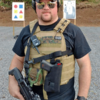Being an avid gun owner and firearms collector, I spend a lot of time in gun shops. Over the years I have seen a lot of things that give me pause, so to speak. I’d like to take a little bit of time to address some considerations and basic etiquette that are important while in a gun shop.
Basic etiquette starts before you even arrive at the gun shop. Public perception about firearms can be different depending on where you live within the US. Some places are very pro-gun, whereas others are very anti-gun. Regardless of where you live, if you are transporting your firearm from your vehicle to a gun shop or gun show it is a good idea to have that firearm preferably unloaded and either in a holster on your side or in a hard or soft case. The reason for this is simple and based on public perception.
It’s not what you are actually doing with your firearm that can cause an issue. It’s what other people perceive you doing with your firearm that can cause alarm. For example: If you drive to a gun shop located in a heavily populated area, park and grab your AK-47 out of the trunk, and start walking towards the building, it would not be unreasonable for someone to be highly alarmed even though you have no bad intentions. The solution is to have your firearm in a case. That would dispel any assumption of malicious intent.
If you are bringing a firearm into a gun shop specifically for the purpose of selling it, trading it or to have it worked on, it is generally a good idea to have the firearm unloaded before arrival. If for some reason you forgot to unload your firearm prior to arrival, make sure to talk to the clerk behind the counter and ask if there is a preferred method for loading and unloading firearms inside that gun shop. It goes without saying, that you are at the highest probability of having a negligent discharge while loading or unloading your firearm, so treat every firearm as if it were loaded at all times.
Many states allow private citizens to carry concealed firearms for personal protection. Personally owned firearms tend to be a topic of discussion at gun shops. If you are carrying a loaded concealed firearm on your person and you are going to allow someone else to handle that firearm, you need to know the store’s policy on loading and unloading and ensure that you pass it to the other person correctly. With very few exceptions, it is generally not advisable to pass loaded firearms to anyone in a gun shop.
Just because a firearm is in a display case at a gun shop does not necessarily mean that it is unloaded. If you want to handle a firearm from a display case, you need to make sure the clerk behind the counter who is passing you the firearm, both visually and physically inspects that the firearm is unloaded and passes it to you with the muzzle down and grip of the firearm towards you. After you accept that firearm, the very first thing that you should do is visually and physically inspect that the firearm is unloaded before any further handling. The reason why we both visually and physically inspect the firearm is because some ammunition is harder to see than others, and in some cases our eyes can deceive us. If we always practice redundancy we might catch something that we otherwise could have missed visually.
We also need to make sure that we are very aware of where our muzzle is pointing at all times. Some gun shops can get very busy and be shoulder-to-shoulder with people. If we are inspecting a firearm and we are checking out the sights, we need to make sure the firearm is pointed in a safe direction. If someone else is handling a firearm and pointing that firearm in an unsafe direction, whether loaded or not, you should address it directly or have the clerk behind the counter address it. If we are following all four of our weapon safety rules and ensure that others around us are doing the same, we will ensure and maintain a safe environment.
This video is a great example of what can happen in a gun shop when weapons safety rules and gun shop etiquette are not followed. In this video, a police officer in Kentucky shoots himself while testing a 38-caliber handgun. Pay attention to the clerk handing him the firearm. Was it passed properly? Did the officer properly inspect it upon receiving it? Was he keeping his finger off the trigger? Was he maintaining muzzle awareness? Was he treating the firearm as if it were loaded? Remember, always practice redundancy, and complacency kills.


